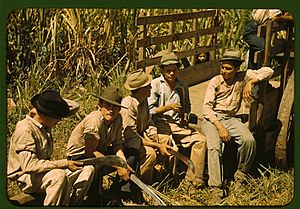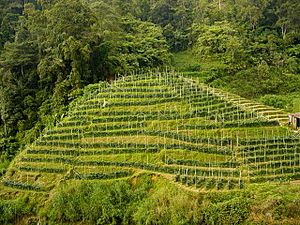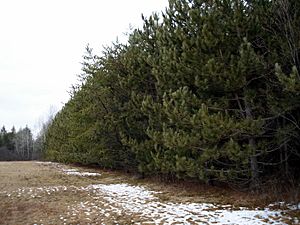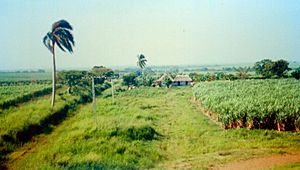Plantation facts for kids
A plantation is a very large farm that grows just one main type of crop. These farms usually grow crops to sell to other countries, rather than for local use. Some common crops grown on plantations include bananas, sugarcane, coffee, tea, cotton, and tobacco.
One challenge with plantations is that they often grow only one type of crop. This is called a monoculture. Growing only one crop can make the plants more easily affected by pests or diseases.
Plantations have a long history. Some of the earliest large farms like these were called latifundia in the Roman Empire. They produced a lot of wine and olive oil to sell. As international trade grew, so did plantation farming. In the past, some plantations were linked to unfair economic systems, where workers faced very difficult conditions or were forced to work.
Contents
What Plantations Grow
Plantations focus on growing specific crops in large amounts. Here are some examples:
Sugar Plantations

Sugarcane was a very important crop in the Caribbean during the 1600s and 1700s. European countries really wanted sugar, and its use grew a lot. Countries like Cuba and Barbados were perfect for growing sugarcane because they had the right soil and climate.
Rubber Plantations
Plantations also grow rubber trees, specifically the Hevea brasiliensis tree. The sap from these trees is used to make natural rubber.
Oil Palm Plantations
Oil palm trees are grown on plantations in many wet, tropical areas. The oil from these palms is used in many products, from food to cosmetics.
Fruit Orchards
Sometimes, large fruit orchards, which are farms that grow many fruit trees, are also considered plantations.
Other Crops
Historically, plantations have grown many other crops. These include tobacco, pineapple, and cotton. Before cotton became very popular in the American South, crops like indigo (used for blue dye) and rice were also grown on plantations.
Plantations and the Environment
Plantations can have a big effect on the local environment.
How Plantations Affect Nature
The biggest impact depends on where a plantation is built. If a natural forest is cut down to make way for a plantation, it can reduce the number of different plants and animals (called biodiversity) and destroy their homes. Sometimes, wetlands are drained to plant trees like pine.
However, if a plantation is started on land that was already used for farming or was badly damaged, it can actually help increase habitat and biodiversity. Plantations can grow well on land that isn't good for other types of farming or where natural forests don't grow back easily.
The type of tree planted also matters. If trees that are not native to the area are used, local animals might not be able to use them for food or shelter. But even non-native trees can help wildlife by creating pathways or protecting native forests nearby.
Managing Plantations for Nature
How a plantation is managed is very important for the environment. The length of time trees are grown before being harvested (called the rotation period) makes a difference. Plantations harvested after a long time (30 years or more) can be similar to natural forests that are managed for wood. This is especially true if native tree species are used. If non-native trees are planted, leaving areas of native trees or natural forest corridors can help reduce the negative impact.
Fishing Plantations
When Newfoundland was settled by England in 1610, the first settlers were called "Planters." Their fishing areas were known as "fishing plantations." These terms were used for a long time.
Some historical fishing plantations in Newfoundland include:
- Sea-Forest Plantation: An early fishing plantation established in the 1600s at Cupids.
- Mockbeggar Plantation: An 18th-century fishing plantation located at Bonavista.
- Pool Plantation: A 17th-century fishing plantation at Ferryland, later destroyed by French invaders.
Images for kids
-
1913 photo: African-Americans picking cotton on a plantation in the South
See also
 In Spanish: Plantación para niños
In Spanish: Plantación para niños






